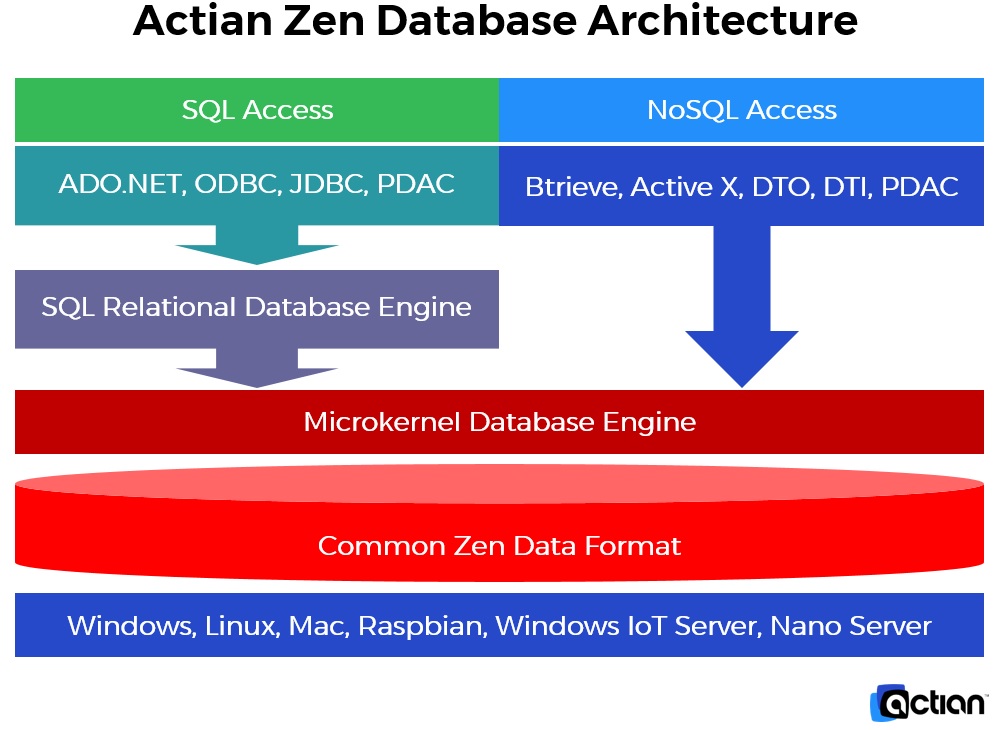Actian Zen Embedded Database Looks To Cover IoT Apps With Zero Management and Nano-Size Footprint
Today’s trends for Internet of Things apps are putting a range of new requirements on a database, beyond those of the typical enterprise-class datacenter. Actian is responding with Actian Zen, a modular, small-footprint embedded database.

Today’s trends for Internet of Things apps are putting a range of new requirements on a database, beyond those of the typical enterprise-class datacenter.
IoT-ready databases often need to be embedded in the application. They also need run without intervention – and be capable of operating in zero management IT environments. Some users even say these database solutions should offer fully-automated installation and operation (with all that complexity hidden from the end user).
Hybrid data management and integration firm Actian is taking these challenges head-on. The Actian Zen Embedded Database offers a modular, small footprint embedded database solution to help developers build IoT apps that will meet the needs to be self-managed.
Rohit De Souza, chief executive of Actian, explained that “developers are looking for a database that is modular, scalable and reliable that can handle the additional data demand driven by today’s demanding IoT applications.”
IoT app use cases require extreme database reliability, modularity and scalability throughout the life of the product, he added. “The stakes are high for the software vendor since thousands of copies of their applications are in use, often on a global basis, so even a minor increase in customer support issues could quickly swamp a support organization and obliterate profit margins.”
According to De Souza, Actian Zen was designed to be “one of the most reliable, low maintenance, high-performance database management systems in the world.”
Actian Zen’s embedded database offers these main benefits:
Large database features, such as full security, encryption, management and monitoring tools, stability and reliability.
Ready for Cloud or SaaS, with licensing models for applications running on a VM as part of a public, private or hybrid cloud, applications deployed in a way that users can’t be counted.
Zero database administration, built for environments where users don’t have the resources to manage a database.
Enhanced C++ API to make it easier for developers to access to the Actian Zen database’s internals and expand the pool of developers capable of building IoT apps with embedded databases.
One last notable feature is what Sousa called ‘next generation’ client cache reporting engine. This enables the offloading of high volume reporting functions from production systems.
Actian Zen Marries Small Footprint with Massively Scalable Data Capabilities
Actian Zen’s approach to meeting IoT developer needs for a smarter, smaller, scalable embedded database, required some innovative thinking about the unique requirements of the massively large data flows associated with IoT use cases.
In a recent Actian blog post, CTO Michael Hoskins, explained the role of the embedded or “edge” database in IoT applications:
The sheer volume and repetition of sensor data make it impractical to imagine “landing” all sensor data in the Cloud. The smarter IoT architectures will provide an intelligent middle tier – a kind of gateway function that resides near the sensors, at the edge. […]
Apart from the obvious advantages of deploying an embedded IoTDB at the “edge” of the network (persistence, security, etc.), you could also apply crucial local filtering (e.g. duplicates, errors, steady states, etc.) and data operations (e.g. sorts, aggregates, model application and local analytics) on the data prior to “landing” the data in the Cloud – a much more efficient and productive setup for cloud-based analytics of sensor data.
Actian Zen supports both SQL and NoSQL access methods, Hoskins noted. Further, Actian Zen’s small footprint can be as small as 30MB. This and other features make it well suited to easily embeddable designs, he added.
In specific, Hoskin listed Actian Zen most important capabilities as being: customizable installation, self-tuning, easy upgrades, seamless backward compatibility and minimal memory requirements. These all combine so that developers “can deliver applications to customers at scale across a wide range of platforms without getting buried by support costs or reliability issues,” he said.
Actian Zen Embedded database is immediately available. Download information can be found here.
Beta versions of Actian Zen Embedded database for Raspbian (the Debian-based computer operating system for Raspberry Pi), Microsoft Windows IoT Core and Microsoft NanoServer are also available for download. “Each of these operating systems is expected to be a significant player in the future IoT ecosystem,” Hoskins added.
GA versions are expected later in 2017, he said.






